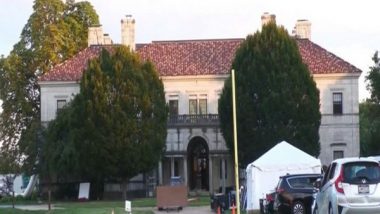One of the most unforgettable aspects of Radium Kagaya International Hotel is, of all places, being inside the elevator. As the glass container traverses up and down, passengers are treated to a vertical panorama of Shoji screened-walls and pinewood-framed corridors interlocking with pitched-roof volumes that give the illusion of little Japanese houses floating in the 14-storey atrium. The typically utilitarian act of taking the elevator is transformed into a mini event that excites even adults.
This is not something many hotels can boast of, but it is part of the allure of the hotel in Beitou – a hot spring destination just half an hour drive from central Taipei. Radium Kagaya sits opposite Beitou Park , which contains the sustainable Beitou branch of the Public Library and the Hot Spring Museum. The latter is a conserved public bathhouse from the Japanese colonial era that, at the time of completion in 1913, was the largest bathhouse in East Asia.

The hotel building is decidedly modern, capped with peaked roofs. But inside, the interior architecture inspired by the sukiya style developed during the Azuchi-Momoyama (1574-1600) and Tokugawa (1603-1867) periods has all the Zen feels of a traditional ryokan. ‘Suki’ refers to the refined and well-cultivated taste of elegant pursuits and is usually associated with the enjoyment of the elaborate Japanese tea ceremony.
Originally applied to teahouse design, sukiya was later incorporated into private homes and restaurants. Radium Kagaya’s interiors eschew heavy, formal luxurious decoration, said Owen Chen, the hotel’s assistant marketing communications manager who took me on a tour of the property. Before that, kimono-clad nakai-san (female butlers) had lined up at the driveway to greet me, exhibiting Japanese omotenashi.
One of them took me to my guestroom, welcoming my stay with a serving of hot matcha and wagashi. “As guests take the elevator to their rooms, they can immediately appreciate the light and deft spatial continuity of the interior architecture,” Chen described. Rounded edges in the timber elements and the absence of nails in the joints of the structures influenced by traditional Japanese building techniques contribute to Radium Kagaya’s distinctive ambience.
The hotel is the only overseas branch of the century-old Kagaya ryokan in Ishikawa Prefecture’s Wakura Onsen that fronts the Nanao Bay on the Noto Peninsula. Established in Meiji 39 (1906), the hotel’s heritage and level of service earned it the first place in The Top 100 Hot Springs Hotels award for 30 consecutive years. It was designed by architect Katsaki Yamamoto, who also designed Radium Kagaya.
For more trivia, Chen escorted me outside the property where a flight of stone steps winds up on the side of the hotel. He explained that the hotel was built next to the original site of Taiwan’s first hot spring hotel, opened in 1896 by a Japanese merchant named Gengo Hirata. That marked the beginnings of the country’s hot spring industry.
The building has been demolished but the stone steps, as well as two pebble pillars, remain as a tribute. Kagaya’s current president Sadahiko Oda picked Beitou to plant the hotel’s first overseas branch because of this bit of history. The 400-sq-m Radium Kagaya opened in 2010 to a cost of US$ 3.
5 120 m b illion (S$159.05 million). There are 90 guestrooms spread across seven room types, ranging from 13 sq m for standard rooms to 32 sq m for suites.
In the hotel are three F&B destinations – Tenshou restaurant, Hiyori lounge and cafe, and the 22-seater Yuduki bar, all of which have bands of windows fronting the park for postcard-worthy views of greenery, mountain ranges and sky. On weekends, locals flock to Beitou to experience nature’s tranquillity while soaking in its public and private hot springs. “The hot springs in the Beitou district are famous for their mild water quality, typically ranging between 37 degrees Celsius and 40 degrees Celsius, and with an acidic pH value of 2.
5 to 6.5,” shared Chan. The region has three varieties of hot spring water – green sulphur, white sulphur and ion oxide, and Radium Kagaya offers two – the milky white sulphur potentially alleviates chronic skin diseases, arthritis and gynaecological sicknesses, and green sulphur could potentially help with skin diseases, gout and muscle pain, and improves respiratory health.
“By employing special sedimentation techniques to filter away impurities, the hot spring water becomes gentler on the skin to provide a delicate bathing experience. Notably, Beitou’s green sulphur springs contain the precious trace element radium that is highly favoured by both local and international tourists. Currently that only exists in Beitou in Taiwan and Tamagawa in Japan,” Chen commented.
Radium Kagaya offers an array of options to experience the hot springs. On the fourth floor is a white sulphur public bath that is separated into men and women. Here, contouring pools and large windows to tree canopy makes it hard to leave.
There are also 17 rooms for private soaks. Each is named after a month in the traditional Japanese calendar, with interior designs based on themes like ceramic, cypress and natural stone. After a hot spring session, one can opt for a Ganbanyoku (dry hot spring) treatment, where one lies on a towel above a bed of local Beitou stone in a Hinoki wood-clad room.
“This wellness service provides guests with a unique thermal experience. The value of Beitou stone lies partly in its trace amounts of radium. The mild radioactive properties and natural energy significantly reduces stress and enhances relaxation,” said Chen, adding that even guests from Japan come all the way to Radium Kagaya just to experience this treatment.
In the guestrooms, Shoji sliding screens, tatami floors and timber accents continue the Japanese sensibility that defines the public areas. “Filled with the scent of Tatami, against the greenery of Beitou Park outside the window, the guestrooms present the serene beauty of Japanese culture in a subtle manner,” Chen highlighted. In the executive suites on the 14th floor, guests can enjoy private hot springs while the special suites on the 16th floor are the most spacious, complete with their own open-air hot spring bath and balcony.
The hotel is also a showcase of Japanese art and craft. Distributed throughout are 850 pieces of art from the Ishikawa Prefecture. “You can find delicate craftsmanship from the Noto Peninsula, including 350-year-old Kutani (fine porcelain) pottery, Wajima lacquerware, gold leaf and Kaga Yuzen (an exquisite kimono silk-dying craft),” said Chen.
He added: “They not only represent Kagaya’s deep cultural heritage from Ishikawa Prefecture, they also enrich the cultural experience of guests and highlight the unique charm of the hotel.” Many of these crafts have been integrated into the interior design. For example, at the reception, a gold inlay of a phoenix rising toward a shimmering sun greets guests.
On the elevator foyer at the second storey, Asakura Isokichi’s Kutani murals depict flowers from the four seasons. Even the elevator interiors exhibit bespoke craftsmanship, being inlaid with gold foil, shaped into the crescent moon, full moon and half moon, and matched with Kaga Yuzen patterned gauze. Of course, no ryokan is complete without exquisite Japanese cuisine and here, Tenshou Restaurant offers contemplative meals set against a backdrop of curved timber ceilings and blond wood floors.
“Radium Kagaya is renowned for its Japanese kaiseki cuisine, meticulously prepared with strictly selected seasonal ingredients from Japan and Taiwan. The cuisine adheres to the Japanese principle of ‘Shun’, which means ‘seasonal’ or ‘in season’, embracing the beauty of each season through timely ingredients,” Chen explained. During my visit, I had the autumn cuisine, where ingredients like persimmons, Hang chrysanthemums, chestnuts, crabs adorned with green leaves and red maple are composed into artful presentations.
Added Chen: “Embodying the culinary spirit of ‘creating from the ingredients, chefs personally visit farms and production sites to integrate the rich flavours of local ingredients into the kaiseki dishes, offering an authentic taste of Yamato (Japanese) elegance.” Yamato can also be found in the hotel’s Japanese’s banquet halls, divided into six venues floored with tatami and timber. One of them, visible from the elevator, evokes a Japanese tea courtyard with an elevated platform edged by sand, rocks and hanging lamps.
Here, guests are treated to a daily tea ceremony performance. While Radium Kagaya’s environs provide a beautiful Instagram backdrop, the real poetry lies in the visceral encounters of service, space and standards. There is a sense of place and escape from the hurly burly of urban anxiety.
Keep your mobile phone away and simply indulge in the sumptuous old-school allure, dedicating all of it to memory..



















